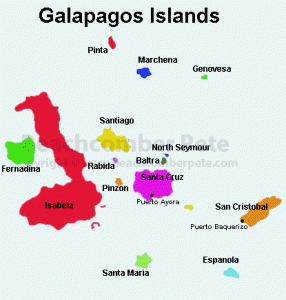Santiago Island, also known as James Island or San Salvador, is centrally located in the archipelago of thirteen islands known as the Galapagos Islands. Due to its location, as well as numerous landing sites available, it is no wonder that this island has a place on the itinerary of most travelers visiting these islands.
This island, as with the other Galapagos Islands, was formed through the action of volcanoes. In the 1600s and 1700s, Santiago Island was a favorite hideout for pirates as well as a base for whalers. They would anchor their ships in one of the bays, and then go to the island to stock up on fresh water as well as tortoises to eat.
 Spending time on Santiago Island is a rewarding experience, especially when traveling to the most popular areas of the island. There are three areas that visitors should try to see during their excursion to this island. The first is Puerto Egas, which one reaches by using a wet landing on the beach. Walking along the beach allows the visitor to view the best tide pools of the 13 islands. Here they can find creatures such as snails, hermit crabs and the Four-Eyed Blenny.
Spending time on Santiago Island is a rewarding experience, especially when traveling to the most popular areas of the island. There are three areas that visitors should try to see during their excursion to this island. The first is Puerto Egas, which one reaches by using a wet landing on the beach. Walking along the beach allows the visitor to view the best tide pools of the 13 islands. Here they can find creatures such as snails, hermit crabs and the Four-Eyed Blenny.
From the beach, the travelers have a choice of two trails to follow. The first takes them inland to the site of a salt crater which, before the 1950s, was used as a salt mine. However, that endeavor was a failure and the site was abandoned. When visiting the area, one can still see some of the equipment left behind. Bird lovers will enjoy this trail as it gives them a chance to view endemic Galapagos hawks as well as Darwin finches and other native birds.
By taking the second trail, the visitor will come to the Fur Seal Grotto, where they can obtain a close up view of fur seals as well as sea lions. The Galapagos Fur Seals are the smallest of the fur seals and were hunted almost to extinction. During the heat of the day, they rest in the small ledges and caves of the lava cliffs, and at night, they feed on fish and squid. With the clear water and the sea lions and seals nearby, many find this area one of their favorites for snorkeling and swimming.
Another destination worth visiting on Santiago Island is Sullivan Bay. It lies on the eastern side of the island, where a large lava flow took place in an eruption in 1897. Because of its composition, the hardened lava looks like it is still molten, and many enjoy walking along this artistic landscape. The only plant found here is the Mollugo plant, and even now, it is very rare. Due to the quickness of the lava flow during the eruption, there are molds of tree trunks, left when the lava surrounded the trunk and incinerated the wood inside. The only thing that remained was the hardened lava that covered it.
North of Puerto Egas, one will find Buccaneer’s Cove. This was a haven for the buccaneers, pirates and whalers in the 18th and 19th centuries. The cove consists of steep cliffs and red-purple sand. Many venture here for the magnificent view. Living among the cliffs one will find large numbers of sea birds.
Not far from Buccaneer’s Cove, one will find Espumilla Beach. Due to changes caused by the El Nino weather feature, the lagoons originally present have disappeared along with the flamingo colony that lived there. However, the area is still important because it is the nesting site for the marine turtles, a very important aspect of the tourism economy of the area.
From far away, Santiago Island looks empty and desolate. However, once a visitor steps foot on the island, it magically comes to life. From the view of the salt crater and the machinery used in that endeavor, to the varied forms of the lava flows, to the unique plants and animals that call this island home, this island is one that the traveler should not overlook. Otherwise, they will be missing sights found nowhere but on Santiago Island.






